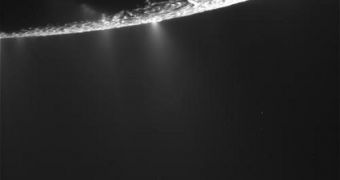The Cassini spacecraft has just sent back the latest pictures that it made of Saturn's moon Enceladus, during the last planned flyby it made of the celestial body as part of its mission. For the next eight years, the moon will enter the “shadows” of winter, as the planet begins its long, cold season. The probe, which is already in its mission extension, is unlikely to last in the harsh conditions it has been calling home for the past few years, for so long. The eighth flyby of this body took place on November 21st, as we reported at the time.
In spite of this taking place just two days ago, the probe has already started transmitting raw temperature data of Enceladus, and also images of the rough terrain at its south pole, the target of the current investigations. Over the next few weeks, experts at the NASA Jet Propulsion Laboratory (JPL), in Pasadena, California, will analyze the data, and then draw new conclusions on the moon based on the readings. In combination with previously obtained information, the new batch of observations will contribute to the creation of the most detailed map of Enceladus' south pole ever.
Not all of the southern hemisphere was imaged by Cassini, but rather only the lower parts of the Saturn-facing hemisphere, mission managers say. A contiguous thermal map of the “tiger stripe” features present at the location will also be created, featuring unprecedented detail. The new flyby was specifically aimed at imaging and analyzing the locations that had eluded previous flights, JPL experts announced before the flight. Cassini passed some 1,600 kilometers (1,000 miles) above the surface of the moon during the E8 flight.
“These first raw images are spectacular, and paint an even more fascinating picture of Enceladus. The Cassini teams will be delving into the data to better understand the workings of this bizarre, active moon,” JPL Cassini project scientist Bob Pappalardo explains. The reason why studying Saturn's moon is so important is the fact that scientists believe it is covered with a thick crust of ice. This could mean that the water and ice vapors it's spewing out of the tiger-stripe fissures are signs of a liquid, underground ocean, which may be large enough to support life, according to some measurements.

 14 DAY TRIAL //
14 DAY TRIAL //